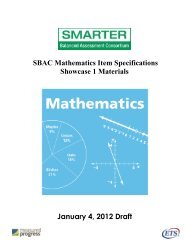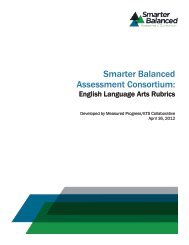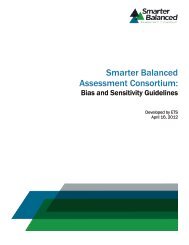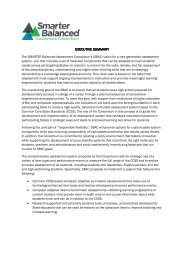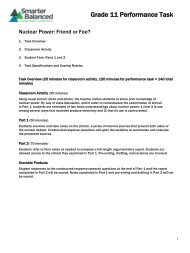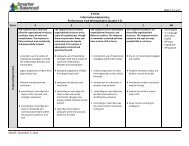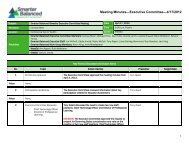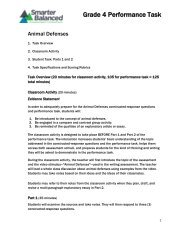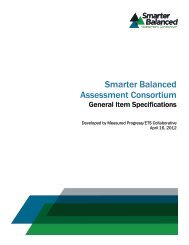Content Specifications for the Summative Assessment of the ...
Content Specifications for the Summative Assessment of the ...
Content Specifications for the Summative Assessment of the ...
Create successful ePaper yourself
Turn your PDF publications into a flip-book with our unique Google optimized e-Paper software.
The Consortium Theory <strong>of</strong> Action <strong>for</strong> <strong>Assessment</strong> Systems: As stated in <strong>the</strong> SMARTER Balanced<br />
<strong>Assessment</strong> Consortium’s (SBAC) Race to <strong>the</strong> Top proposal, “<strong>the</strong> Consortium’s Theory <strong>of</strong> Action calls<br />
<strong>for</strong> full integration <strong>of</strong> <strong>the</strong> learning and assessment systems, leading to more in<strong>for</strong>med decision-making<br />
and higher-quality instruction, and ultimately to increased numbers <strong>of</strong> students who are well prepared<br />
<strong>for</strong> college and careers.” (p. 31). To that end, SBAC’s proposed system features rigorous Common Core<br />
State content standards; common adaptive summative assessments that make use <strong>of</strong> technologyenhanced<br />
item types, and include teacher-developed per<strong>for</strong>mance tasks; computer adaptive interim<br />
assessments—reflecting learning progressions—that provide mid-course in<strong>for</strong>mation about what<br />
students know and can do; instructionally sensitive <strong>for</strong>mative tools, processes, and practices that can be<br />
accessed on-demand; focused ongoing support to teachers through pr<strong>of</strong>essional development<br />
opportunities and exemplary instructional materials; and an online, tailored, reporting and tracking<br />
system that allows teachers, administrators, and students to access in<strong>for</strong>mation about progress towards<br />
achieving college- and career-readiness as well as to identify specific strengths and weaknesses along<br />
<strong>the</strong> way. Each <strong>of</strong> <strong>the</strong>se components serve to support <strong>the</strong> Consortium’s overarching goal: to ensure that<br />
all students leave high school prepared <strong>for</strong> post-secondary success in college or a career through<br />
increased student learning and improved teaching. Meeting this goal will require <strong>the</strong> coordination <strong>of</strong><br />
many elements across <strong>the</strong> educational system, including but not limited to a quality assessment system<br />
that strategically “balances” summative, interim, and <strong>for</strong>mative components (Darling-Hammond &<br />
Pecheone, 2010; SBAC, 2010).<br />
The proposed SBAC ELA & literacy assessments and <strong>the</strong> assessment system are shaped by a set <strong>of</strong><br />
characteristics shared by <strong>the</strong> systems <strong>of</strong> high-achieving nations and states, and include <strong>the</strong> following<br />
principles (Darling-Hammond, 2010):<br />
8<br />
1) <strong>Assessment</strong>s are grounded in a thoughtful, standards-based curriculum and are managed<br />
as part <strong>of</strong> an integrated system <strong>of</strong> standards, curriculum, assessment, instruction, and teacher



